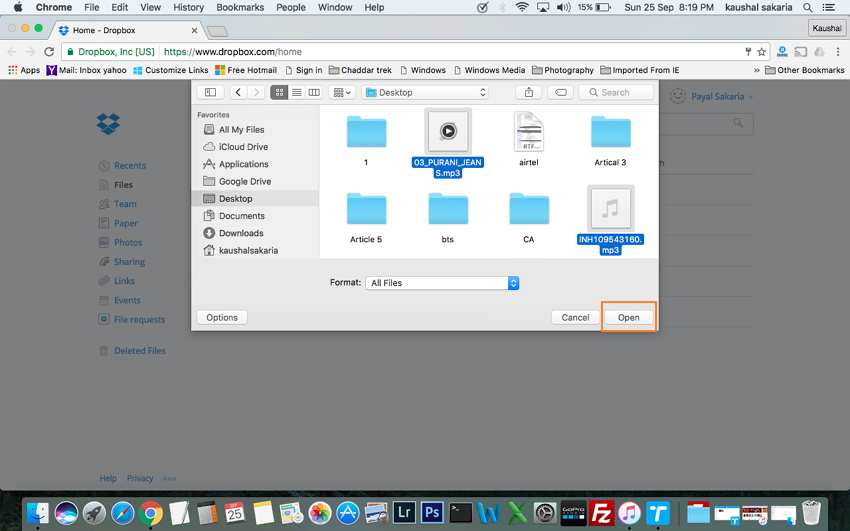Using Dropbox For Photo Storage With Mac

Most of us know that Dropbox is a cloud storage service that syncs files in a folder on your Mac with your account in the cloud. There is, however, a great deal more to Dropbox than just storing. How to use Dropbox to Backup Your Photos. It’s free to sign up, and comes with 2GB of free storage, or use this link to get an extra 500mb storage for free. Click on the link and enter your First Name, Last Name, Email Address, and a Password. So you'll always be able to show your mother the recent antics of little Johnny! Even if there isn’t explicit Dropbox support, you can sometimes synchronize an app’s data files by (a) finding out where those files are stored and then (b) using the symbolic link trick to. Before Dropbox became popular, there was iDisk, which was Apple’s cloud storage system. IDisk allowed you to store documents, pictures, QuickTime files, and PDFs in one cloud-based “drive.”.
This post is sponsored by MacPaw, maker of CleanMyMac. Clear out your Downloads folder The Downloads folder on your Mac is one of the biggest culprits of wasted storage space. Photo: Ally Kazmucha/The App Factor The Downloads folder on my Mac is a constant wasteland of files I only needed temporarily. Then when I was done with them, they end up staying there for months on end. Remember, almost everything you download from any web browser gets dumped into the general Downloads folder. In many cases this also includes files sent to you through other apps as well. This is why I suggest going through that folder periodically to file away things you want to save and permanently trash things you don’t need.

At one point, my Downloads folder swelled to over 50GB — and about 75 percent of it was crap I didn’t need. If you’re getting out-of-storage messages on your Mac, the first place you should look at clearing out is absolutely your Downloads folder. Delete apps you don’t use or need Ever download apps you never ended up using again?
Delete them to regain more storage. Photo: Ally Kazmucha/The App Factor These may seem obvious but to some people, it isn’t. Go through your applications folder (or LaunchPad) and delete any apps you haven’t opened recently. As a general rule, I try and delete any apps I haven’t opened in 6 months or more. If you purchased them from the Mac App Store, you can re-download them whenever you’d like at no cost to you. If you purchased them outside the Mac App Store, just be sure you’ll have a way to obtain them again in the future if you need to (or you can transfer them to an external drive if you’d like). Check for duplicate iPhoto libraries If you’re using the new Photos app on your Mac (which you should be by now), make sure to delete your old iPhoto libraries or your photos are duplicated.
Dropbox For Mac Free
Photo: Ally Kazmucha/The App Factor If you’re using the newer Photos app on your Mac, but you previously used iPhoto, the odds of you having duplicate iPhoto libraries floating around on your hard drive are pretty high. I actually had two additional libraries on my iMac, and I have no idea why. I’m assuming at some point I did a restore and iPhoto didn’t know where to drop my photos for some reason, so it created an entirely new library.
Using Dropbox For Photo Storage With Mac Free
Whatever the reason, I definitely didn’t need extras, and clearing them off allotted me almost 100GB of extra storage space. So before doing anything else, be sure you don’t have additional libraries on your Mac. If you aren’t sure how, you can follow our guide for deleting additional iPhoto libraries: • 4. Use DaisyDisk, or a utility like it DaisyDisk, or a utility like it, can help you find large files hiding on your Mac’s hard drive.
Using Dropbox For Photo Storage
Photo: Ally Kazmucha/The App Factor Most of us have tons of files on our Macs that we don’t necessarily need and not only that, sometimes there are files there we don’t even know we have. This can be caused by apps that were deleted long ago, or even duplicates. I had a friend discover tons of video on her hard drive she didn’t even know she had stored on her Mac. It had come over from several backups and they were already backed up to an external, leaving no need them to take up space. While there are lots of utilities like, it’s my favorite because it’s simple to use and shows you exactly where your storage is being taken up. I’ve found it to be an indispensable tool when it comes to finding files and storage hungry apps I didn’t even know were there.
